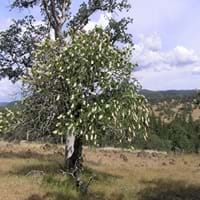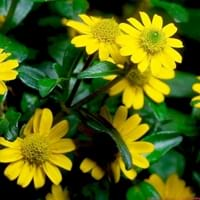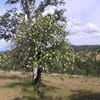Life Span
Perennial
Annual
Types
Not Available
Ornamental
Habitat
Hillside
Rocky areas
USDA Hardiness Zone
7-9
6-9
Sunset Zone
3a, 3b, 4, 5, 6, 7, 8, 9, 10, 14, 15, 16, 17, 18, 19, 20, 21, 22, 23, 24
A1, A2, A3, H1, H2, 1a, 1b, 2a, 2b, 3a, 3b, 4, 5, 6, 7, 8, 9, 10, 11, 12, 13, 14, 15, 16, 17, 18, 19, 20, 21, 22, 23, 24
Habit
Oval or Rounded
Prostrate/Trailing
Flower Color
White, Pink
Yellow, Gold, Black
Flower Color Modifier
Bicolor
Bicolor
Fruit Color
Yellow Brown
Chocolate, Black
Leaf Color in Spring
Light Green
Green
Leaf Color in Summer
Green
Green
Leaf Color in Fall
Not Available
Green
Leaf Color in Winter
Not Available
Light Green
Plant Season
Spring, Summer, Fall, Winter
Summer, Fall
Sunlight
Full Sun, Partial Sun
Full Sun
Type of Soil
Clay, Loam, Sand
Loam, Sand
The pH of Soil
Acidic, Neutral
Neutral
Soil Drainage
Well drained
Well drained
Bloom Time
Late Spring, Early Summer
Indeterminate
Tolerances
Drought, Salt
Drought
Where to Plant?
Ground
Ground
How to Plant?
Seedlings
Seedlings
Plant Maintenance
Medium
Medium
Watering Requirements
Keep the ground moist but not water-logged, Requires regular watering, Requires watering in the growing season
Medium
In Summer
Lots of watering
Lots of watering
In Spring
Moderate
Moderate
In Winter
Average Water
Average Water
Soil pH
Acidic, Neutral
Neutral
Soil Type
Clay, Loam, Sand
Well drained
Soil Drainage Capacity
Well drained
Well drained
Sun Exposure
Full Sun, Partial Sun
Full Sun
Pruning
Remove damaged leaves, Remove dead leaves, Remove dead or diseased plant parts
Remove damaged leaves, Remove dead branches, Remove dead leaves
Fertilizers
All-Purpose Liquid Fertilizer
All-Purpose Liquid Fertilizer
Pests and Diseases
Red blotch
Red blotch
Plant Tolerance
Drought
Drought
Flower Petal Number
Not Available
Single
Foliage Texture
Medium
Fine
Foliage Sheen
Glossy
Matte
Attracts
Birds, Butterflies
Butterflies
Allergy
Not Available
Not Available
Aesthetic Uses
Beautification, Landscape Designing, Showy Purposes
Ground Cover, Showy Purposes
Beauty Benefits
Not Available
Not Available
Environmental Uses
Air purification
Air purification
Medicinal Uses
Not Available
Not Available
Part of Plant Used
Fruits
Flowers, Leaves
Other Uses
Decoration Purposes, Showy Purposes, Used as Ornamental plant
Showy Purposes
Used As Indoor Plant
No
No
Used As Outdoor Plant
Yes
Yes
Garden Design
Dried Flower, Everlasting, Feature Plant, Hedges, Mixed Border, Screening, Wind Break
Groundcover
Botanical Name
AESCULUS californica
SANVITALIA procumbens
Common Name
California Buckeye
Creeping Zinnia
In Hindi
कैलिफोर्निया Buckeye
SANVITALIA procumbens
In German
California Buckeye
Husarenknopf
In French
California Buckeye
procumbens Sanvitalia
In Spanish
California Buckeye
procumbens Sanvitalia
In Greek
Καλιφόρνια Buckeye
procumbens SANVITALIA
In Portuguese
California Buckeye
procumbens Sanvitalia
In Polish
Kalifornia Buckeye
procumbens SANVITALIA
In Latin
California Buckeye
Sanvitalia procumbens
Phylum
Magnoliophyta
Magnoliophyta
Class
Magnoliopsida
Magnoliopsida
Order
Sapindales
Asterales
Family
Sapindaceae
Asteraceae
Genus
Aesculus
Sanvitalia
Clade
Angiosperms, Eudicots, Rosids
Angiosperms, Asterids, Eudicots
Tribe
Not Available
Heliantheae
Subfamily
Hippocastanoideae
Asteroideae
Difference Between California Buckeye and Creeping Zinnia
If you are confused whether California Buckeye or Creeping Zinnia are same, here are some features about those plants to help you choose better. Many people think that these two plants have the same characteristics, but one can see California Buckeye and Creeping Zinnia Information and learn more about it. Fertilizers required for proper growth of California Buckeye are All-Purpose Liquid Fertilizer, whereas for Creeping Zinnia fertilizers required are All-Purpose Liquid Fertilizer. Hence, one should know the basic difference between California Buckeye and Creeping Zinnia if you are planning to have them in your garden to enhance its beauty.
<
Flowering PlantsImportance of California Buckeye and Creeping Zinnia
Want to have the most appropriate plant for your garden? You might want to know the importance of California Buckeye and Creeping Zinnia. Basically, these two plants vary in many aspects. Compare California Buckeye and Creeping Zinnia as they differ in many characteristics such as their life, care, benefits, facts, etc. Every gardener must at least have the slightest clue about the plants he wants to plant in his garden. Compare their benefits, which differ in many ways like facts and uses. The medicinal use of California Buckeye is Not Available whereas of Creeping Zinnia is Not Available. California Buckeye has beauty benefits as follows: Not Available while Creeping Zinnia has beauty benefits as follows: Not Available.
Compare Facts of California Buckeye vs Creeping Zinnia
How to choose the best garden plant for your garden depending upon its facts? Here garden plant comparison will help you to solve this query. Compare the facts of California Buckeye vs Creeping Zinnia and know which one to choose. As garden plants have benefits and other uses, allergy is also a major drawback of plants for some people. Allergic reactions of California Buckeye are Not Available whereas of Creeping Zinnia have Not Available respectively. Having a fruit bearing plant in your garden can be a plus point of your garden. California Buckeye has showy fruits and Creeping Zinnia has no showy fruits. Also California Buckeye is not flowering and Creeping Zinnia is not flowering . You can compare California Buckeye and Creeping Zinnia facts and facts of other plants too.





